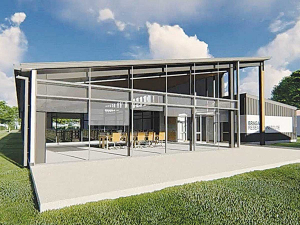Fieldays’ sustainability credentials getting greener
The New Zealand National Fieldays Society has achieved a major sustainability milestone - reducing its greenhouse gas emissions and reaching the target five years early.
 Architect’s rendering of the new Research Winery and conference facility in Blenheim, which will be operational for vintage 2020.
Architect’s rendering of the new Research Winery and conference facility in Blenheim, which will be operational for vintage 2020.
The Bragato Research Institute is breaking ground in terms of its research winery.
The goal was always to both build and operate the winery sustainably. That is now coming to fruition.
The research winery, which will be ready in time for vintage 2020, is being built to a 5-star Greenstar standard, which will be certified by the NZ Green Building Council, of which BRI are a Member.
Once completed, it will be the first building in Marlborough to be built to this standard, and only the second in the top of the south.
In its design, the research winery aims to minimise, the use of crucial resources, like energy, water and raw materials; avoid any adverse environmental impact caused by the winery facilities and activities throughout its life cycle; and provide an environment that is comfortable, safe, and productive.
Winery features that will reduce resource consumption include;
• Greenstar rating for the build.
• Rain water harvesting from the winery roof. Rain water will be stored, filtered and UV-treated for use in the winery.
• Building a cleaning-in-place (CIP) station that will reduce cleaning requirements, and be used to collect and recycle winery waste water.
• Solar energy generation. Photovoltaic panels on the winery roof will produce up to 30 percent of the winery’s power requirement.
• Upcycling of Totara timber cuve’s donated by Villa Maria into a conference room table, in partnership with the NMIT carpentry unit and students.
• Baseline monitoring of water and energy consumption through metering.
• Optimisation of fermentation temperature control through VinWizard, this will aid efficient energy usage.
• Monitoring of light, heat, energy, water and air quality through a building management system (BMS) to plan future management of resource consumption.
The implementation of a sustainable waste management plan will limit adverse environmental impact caused by waste produced as a by-product of winery operations. This will include;
• recycling,
• composting,
• waste water treatment,
• grape marc repurposing & research,
The winery has been designed to provide a safe and functional space for employees and researchers to work in. Winery design aspects which encompass this are;
Natural light and ventilation, and both heat and light sensors
Carbon dioxide alarms both inside and outside the building,
A conference room that adjoins the research winery via a glass wall, will provide an open space for teaching, workshops, meetings and visitors. The activity inside the winery can be viewed without physical access, avoiding Health and Safety issues.
A winery that can accommodate students from NMIT and other education programmes, providing learning opportunities and building research capability for the future.
Once operational the BRI will aim to advance the research wineries commitment to sustainability by engaging with the SWNZ Continuous Improvement program.
Built on the Marlborough Research Centre site in Blenheim, the winery and the Research Institute strengthens the partnership between BRI, the Nelson Marlborough Institute of Technology (NMIT), and Plant & Food Research (PFR). The location also allows BRI to continue to work alongside New Zealand Winegrowers and Wine Marlborough who are all on the same site, as part of the vision for an integrated hub of viticulture and oenology.